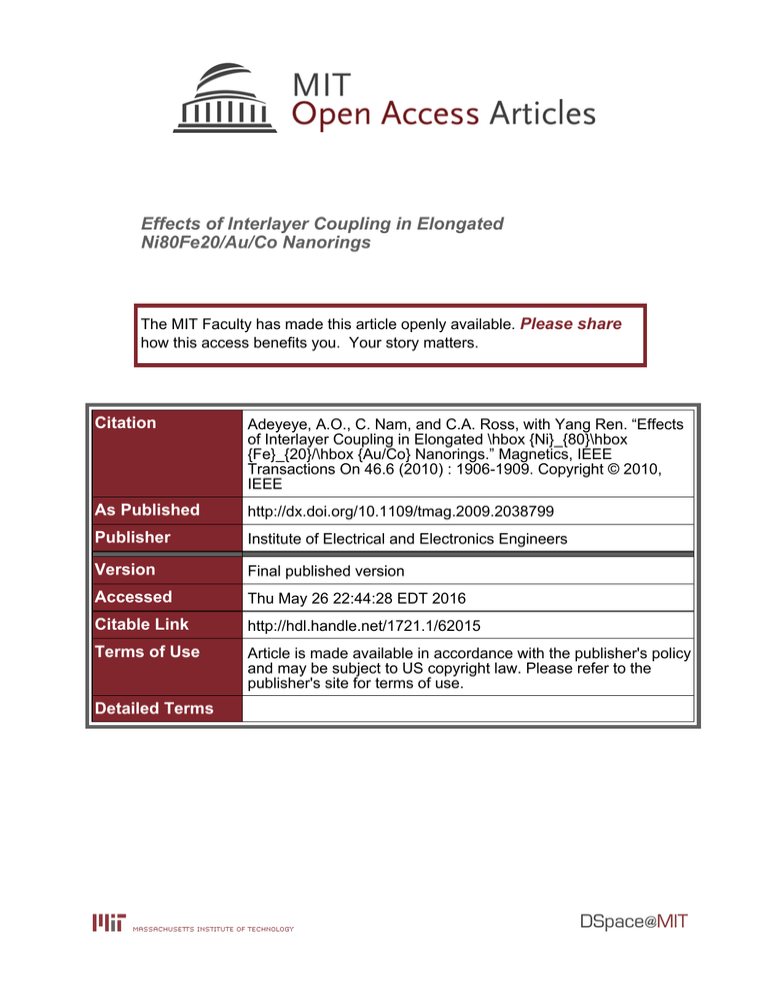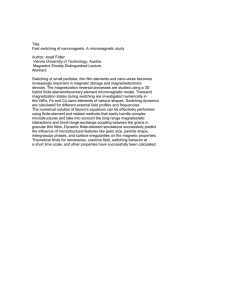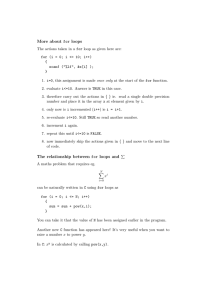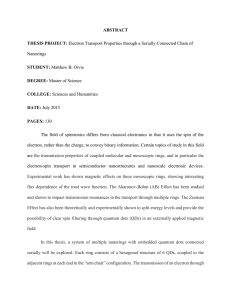Effects of Interlayer Coupling in Elongated Ni80Fe20/Au/Co Nanorings Please share
advertisement

Effects of Interlayer Coupling in Elongated
Ni80Fe20/Au/Co Nanorings
The MIT Faculty has made this article openly available. Please share
how this access benefits you. Your story matters.
Citation
Adeyeye, A.O., C. Nam, and C.A. Ross, with Yang Ren. “Effects
of Interlayer Coupling in Elongated \hbox {Ni}_{80}\hbox
{Fe}_{20}/\hbox {Au/Co} Nanorings.” Magnetics, IEEE
Transactions On 46.6 (2010) : 1906-1909. Copyright © 2010,
IEEE
As Published
http://dx.doi.org/10.1109/tmag.2009.2038799
Publisher
Institute of Electrical and Electronics Engineers
Version
Final published version
Accessed
Thu May 26 22:44:28 EDT 2016
Citable Link
http://hdl.handle.net/1721.1/62015
Terms of Use
Article is made available in accordance with the publisher's policy
and may be subject to US copyright law. Please refer to the
publisher's site for terms of use.
Detailed Terms
1906
IEEE TRANSACTIONS ON MAGNETICS, VOL. 46, NO. 6, JUNE 2010
Effects of Interlayer Coupling in Elongated Ni80Fe20 Au/Co Nanorings
Yang Ren1;2 , Adekunle Olusola Adeyeye1 , C. Nam3 , and Caroline A. Ross3
Information Storage Materials Laboratory, Department of Electrical and Computer Engineering,
National University of Singapore, Singapore 117576, Singapore
Singapore-MIT Alliance, Singapore 117576, Singapore
Department of Materials Science & Engineering, Massachusetts Institute of Technology, Cambridge, MA 02139
We describe the magnetization reversal processes in multilayer elongated Ni80 Fe20 (10 nm) Au(
= 0 to 20 nm)
Co(20 nm) Si(001) nanorings. For a field applied in-plane along the long axis, the hysteresis loops display a two-step switching for
both = 0 nm and 2 nm, and a three-step switching for = 10 nm and 20 nm. Onion-to-vortex and vortex-to-reverse onion state
transitions occur for a thin Au spacer due to strong exchange coupling between the layers. For a thick Au spacer layer, the Ni80 Fe20
layer switches first, then a two-step reversal of the Co, correlated with domain motion in the Ni80 Fe20 , occurs without the formation of
vortex states as a result of magnetostatic interactions. There is a good agreement between the experimental results and micromagnetic
simulations.
Index Terms—
Co Au Ni80 Fe20 , elongated nanorings, exchange coupling, MOKE.
I. INTRODUCTION
ATTERNED trilayer ferromagnetic/nonmagnetic/ferromagnetic (F/N/F) systems are of fundamental interest
due to the strong interactions between the magnetic layers,
and have application in magnetic random access memory,
magneto-electronic devices, and especially GMR multilayers
[1], [2]. Interlayer magnetostatic coupling plays a significant
role when the lateral size of the device is reduced [3], and
both magnetostatic and exchange coupling affect the switching
process and coercive field of the patterned F/N/F system,
depending on the thickness and material of the spacer layer [4].
Recently, interlayer exchange coupling has been widely researched in nanostructures with various dimensions and materials of both the ferromagnetic layers and spacer layer [4]–[10].
Buchanan et al. [4] investigated the magnetization reversal in
patterned Py/Cu/Py nanodots and observed a state where two
magnetic disks separated by a nonmagnetic spacer each support
single vortices. Smith et al. [5] studied the interlayer coupling
in patterned submicron Co/Au/Ni nanostructures with different
shapes such as diamonds, ellipses, and rectangles using off-axis
electron holography.
However, there are limited reports on the competing effects
of interlayer exchange and magnetostatic coupling in magnetic
nanorings. Magnetic nanorings have been studied due to their
potential applications in the high density magnetic-random
access memory (MRAM) [11] or logic devices [12]. A thin film
ring shows two characteristic magnetic configurations. One is
the vortex state with a low remanence and stray field where
the magnetization has a closed flux configuration, and another
is called the onion state with two opposite head-on (180 )
P
Manuscript received October 30, 2009; accepted December 09, 2009. Current
version published May 19, 2010. Corresponding author: A. O. Adeyeye (e-mail:
eleaao@nus.edu.sg).
Color versions of one or more of the figures in this paper are available online
at http://ieeexplore.ieee.org.
Digital Object Identifier 10.1109/TMAG.2009.2038799
domain walls [13]. In this work we systematically investigate
the magnetization reversal processes in multilayer elongated
nanorings as a function
of the thickness of Au by means of MOKE measurements.
Minor loops were also measured to separate the magnetic
and Co layers. We show
switching behavior of the
that the switching process differs qualitatively depending on
how effectively the Au layer exchange-decouples the layers.
The combined effects of interlayer coupling and ring spacing on
the switching behavior are correlated with 3-D micromagnetic
simulations together with magnetic force microscopy.
II. EXPERIMENTAL DETAILS
Periodic arrays of elongated rings with varied interring
spacing were fabricated by deep ultra violet lithography
at 248 nm exposure wavelength followed by lift-off on
a silicon substrate [14].
multilayers shown
in Fig. 1(a) were deposited using electron beam evaporation at
. The pressure was maintained at
a rate of 0.2
during the deposition process. To prevent oxidation, all samples
had a 3 nm-thick Au capping layer on the top. Successful lift-off
was determined by the color change of the patterned film and
confirmed by examination under a scanning electron microscope (SEM). Fig. 1(b) is a SEM micrograph of arrays of ring
, length
, aspect ratio
width
along the long axis, and inter-ring spacing
. The
collective magnetic switching behavior of ring arrays was
characterized by focused magneto-optical Kerr effect (MOKE)
magnetometry at room temperature with a spot size of about
. The magnetic states of the elongated rings were im5
aged by magnetic force microscopy (MFM). A magnetized Si
low-moment tip coated with CoCr at a scan height of 100 nm
was used. Three dimensional micromagnetic simulations were
performed for the patterned F/N/F system with varied Au thickness by using the 3D object oriented micromagnetic framework
(OOMMF) code from the National Institute of Standards and
Technology [15]. The material parameters used are as follows:
and
saturation magnetization
0018-9464/$26.00 © 2010 IEEE
REN et al.: EFFECTS OF INTERLAYER COUPLING IN ELONGATED Ni
Fe
Au/Co NANORINGS
1907
Fig. 1. (a) The trilayer structure of the elongated nanorings with varying spacer
thickness (t), and (b) a SEM image of the elongated nanorings.
3. (a) Minor loops of the elongated Ni Fe (10 nm)=
Au(t)= Co(20 nm) nanorings with t = 0 nm to 20 nm for a field applied
Fig.
along the long axis of the rings, starting from positive saturation. The insets
show the corresponding minor hysteresis loops for the field range of 350
Oe to +350 Oe. (b)–(e) Remanent MFM images after saturation for the
Ni Fe (10 nm)=Au(t)=Co(20 nm) nanorings with (b) t = 0 nm, (c)
t = 2 nm, (d) t = 10 nm, (e) t = 20 nm. Dashed lines indicate vortex-state
rings.
0
Fig. 2. Hysteresis loops for (a) the continuous films Ni Fe (10 nm)=
Au(t)=Co(20 nm) with various thickness t from 0 nm to 20 nm, (b) the
corresponding elongated nanoring arrays for a field applied along the long
axis of the rings, and (c) The field-derivative of the ascending branch of the
hysteresis loops. The peaks correspond to the steps in the hysteresis loops. The
inset shows the surface topography of Au (2 nm) grown on Co (20 nm) using
atomic force microscopy.
, exchange stiffness constant
and
,
0.5. The anisotropy constant was set to
damping parameter
zero to model polycrystalline Co. The size of the unit cell used
in the x, y, and z directions respectively,
is
cubic cells for the
and the simulation used
single Co layer.
III. RESULTS AND DISCUSSION
Fig. 2(a) shows the MOKE M-H loops of the continuous films
as a function of Au spacer layer thickness. The MOKE signal is
layer, and shows a decrease in coersensitive to the top
civity as the Au layer thickness increases and the
and
Co layers become exchange-decoupled. However, for the elongated nanorings, the light scatters from the edges of the rings, so
the MOKE signal is sensitive to both top and bottom layers. The
corresponding MOKE M-H loops as a function of Au spacer
layer thickness for field applied along the long axis of the rings
are shown in Fig. 2(b). The magnetostatic interaction between
adjacent rings is neglected due to the relatively large inter-ring
spacing [16].
and 2 nm, two significant steps are observed correFor
120 Oe) and vortex-to-responding to the onion-to-vortex (
verse onion (
600 Oe) transitions. For the case of
,
the correlated reversal in the two FM layers is caused by the
strong ferromagnetic exchange coupling between them. For Au
(2 nm) grown on the Co layer, the spacer layer is discontinuous and an island structure is formed, shown in the inset of
Fig. 2(c), where the heights of the island are around 2–3 nm. As
a result, the two FM layers are still ferromagnetically coupled
through pinholes in the Au, resulting in a correlated reversal of
and 20 nm,
the bottom layer and top layer. However, at
, the
a three-step switching is observed. Compared to
sample shows a lower field for the second step and
the plateau between the second and the third switching events is
greater.
Fig. 2(c) displays the derivative with respect to field for the
loops with varied spacer layer thickness. Peaks 1 to 6 indicate
to
for the hysteresis loops as
the average switching fields
a function of . All the loops show a common third peak (high
which is insensitive to the Au
field peak) at
thickness. This is attributed to the Co (hard) layer switching
and 2 nm, the only other
to a reverse onion state. For
1908
IEEE TRANSACTIONS ON MAGNETICS, VOL. 46, NO. 6, JUNE 2010
Fig. 4. Simulated major hysteresis loops with magnetic configurations of the elongated Ni Fe (10 nm)=Au(t)=Co(20 nm) nanorings for (a) t = 0 nm, (b)
t = 2 nm, (c) t = 10 nm, (d) t = 20 nm, and (e) isolated Co nanoring (20 nm) shown at various fields. For each field, the Co (left) and Ni Fe (right) layers
are shown separately. The bottom row shows the reversal of an isolated Co ring.
peak present occurs at
for
and at
for
. This is attributed to the onion-to-vortex
and Co layers. For
transition for the coupled
and 20 nm, the first step occurs at
, corlayer reversal, and the middle step
responding to the
for
, and
occurs at
for
, corresponding to the start of reversal in the Co
layer.
To understand the details of the switching behavior, minor
loops were measured from positive saturation to a negative field
of 400 or 500 Oe, then back to positive saturation, and the
switching fields were found by differentiation of the loops. We
also show the MOKE minor loops in the field range of 350
and 2
to 350 Oe in the insets of Fig. 3(a). For
nm, each minor loop descending from saturation shows one-step
and
, corswitching at a field
responding to the onion-to-vortex transitions for the coupled top
and bottom layers, the same process as in the major loops. The
ascending loops show that the onion state is recreated at 600
Oe, again, the same as in the major loops. The field range of
350 Oe shows no hysteresis indicating reversible behavior:
the rings stay in a reverse onion state. This data is consistent with
strong coupling between the layers, such that the rings undergo
an onion-vortex transition at 120 Oe and a vortex-onion transition at 600 Oe.
, an asymmetric two-step switching is observed
At
in the minor loop. The switching fields
and
in the descending branch correspond to those of the major loop, and in
350 Oe, clear two-step switching is seen.
the field range of
We assume that the low-field step corresponds to the switching
layer, which is exchange-decoupled from the
of the
Co but magnetostatically coupled to it, promoting parallel alignonion states. The second step repment of the Co and
resents partial reversal of the Co. It is possible that pinholes
still enable some exchange coupling between the layers, which
competes with the magnetostatic interactions that favor antipar, the steps are sharper and the
allel alignment. At
switching processes occur more abruptly. We expect exchange
coupling to be absent (suggested also by the lower coercivity of
in the continuous film) and reversal is governed
the
by magnetostatic effects. From its state at 400 Oe, the ring
returns to positive saturation via a three step process, the first
layer realigning anof which probably represents the
tiparallel to the Co layer.
The effects of interlayer thickness on the switching behavior
were also investigated by MFM which is primarily sensitive to
the stray field from the top layer due to its proximity to the tip.
The experiments were performed at remanence after saturating
the samples along the long axis. Fig. 3(b)–(e) shows remanent
, shown
MFM images of the elongated nanorings. For
in Fig. 3(b), the rings appear as onion states in which the two
walls (showing as black or white) may be on the same or opposite sides of the ring. Additionally, about 35% of the rings are in
a vortex state at remanence, with little MFM contrast. The rings
have a spread in switching field, and because the onion-vortex
switching field is small, some of the rings have already switched
into vortex states at zero field. Fig. 3(c) shows the remanent
. Most rings form onion states with misalignstates for
ment of the walls away from the field axis, but vortex states were
also observed in less than 20% of the rings. The results are in
a very good agreement with the hysteresis loops for
and 2 nm, respectively. For
and 20 nm, the remanent
states present onion states, shown in Fig. 3(d) and (e), without
any vortex states. In all the samples, the domain walls are preferentially located at corners of the rings, as seen in single-layer
rings studied earlier [17]
3-D micromagnetic simulations were performed for the
elongated nanorings with varied spacer layer thickness.
REN et al.: EFFECTS OF INTERLAYER COUPLING IN ELONGATED Ni
Fe
Au/Co NANORINGS
Figs. 4(a)–(d) show the simulated M-H loops and magnetic
ring
configurations for a
0 to 20 nm for a field applied along the long axis.
with
Compared with Fig. 2(b), the simulated M-H loops have a good
agreement with the corresponding experimental hysteresis
, a two-step switching
loops. For the coupled ring at
is observed in both experimental and simulated M-H loops,
while in the other simulated cases, where exchange coupling
is broken, three-step switching is seen. In the right column of
Figs. 4(a)–(d), the simulated micromagnetic configurations are
shown at various points on the simulated hysteresis loops.
, as the applied field is reduced from posiFor
, both
and Co layers
tive saturation to the field
form an onion state, shown in Fig. 4(a), just before the step.
, the layers form a vortex state, and after the
At higher field
second step, a reverse onion state. This is in excellent agreement with the experimental data, including the magnitudes of
10–20 nm, a qualitatively different
the switching fields. For
behavior is seen. The first, low-field step shows complete relayer from onion to reverse onion state,
versal of the
without forming a vortex; the Co layer is unchanged. The second
step corresponds to a partial reversal of the Co layer by doand
). It is interesting to note that
main wall motion (
the
layer does not remain invariant, but instead the
walls in its reverse-onion state are displaced. This has the reand Co layers aligned antiparallel,
sult of making the
which is a result of the magnetostatic interaction between them.
The third step corresponds to the formation of a reverse onion
state in the Co, and the realignment of the reverse onion state in
, so that the ring is saturated. For comparison, the
the
figure also shows the reversal process of an isolated 20 nm Co
ring, which reverses conventionally via a vortex state [Fig. 4(e)].
The behavior for thick may be compared to that of Co(8 nm)/
Cu(6 nm)/NiFe (6 nm) elliptical rings reported previously [7].
These rings, which had thinner layers and a narrower ring width
compared to the rings of the present study, also showed threestep switching over a range of geometries. In this case the first
step corresponded to the onion-reverse onion switch of the NiFe
layer (the transition occurs by propagation of reverse domains
from the ends of the ring, without forming a vortex, due to
the influence of magnetostatic interaction from the Co), and
the second and third steps to the Co layer onion-vortex and
vortex-reverse onion transitions. In the present study, the thicker
magnetic layers increase the importance of interlayer magnetostatic coupling, and the wider ring makes nonuniform states
easier to form, facilitating the anti-alignment of the Co and NiFe
layers during the Co reversal, which did not happen in the previous work.
IV. SUMMARY
We describe the magnetization reversal processes in multilayer elongated
nanorings as a function of the Au thickness . For
and
2 nm, strong ferromagnetic coupling dominates the magnetic
switching process and the two FM layers reverse together in
a two-step switching corresponding to onion-to-vortex and
1909
and 20 nm,
vortex-to-reverse onion transition. For
magnetostatic coupling between the two FM layers is significant. The hysteresis loops show a three-step switching in which
layer reverses first, followed by two-step reversal
the
of the Co. The Co reversal is accompanied by displacements of
, which tends to
domain walls in the already-reversed
adopt a magnetization state that is antiparallel to that of the Co
as a result of magnetostatic coupling.
ACKNOWLEDGMENT
This work was supported by the Singapore-MIT Alliance.
REFERENCES
[1] J. G. Zhu and Y. Zheng, “The micromagnetics of magnetoresistive
random access memory,” in Spin Dynamics in Confined Magnetic
Structures: I. Topics in Applied Physics, B. Hillebrands and K. Ounadjela, Eds. Berlin: Springer, 2002, vol. 83, pp. 289–325.
[2] M. M. Miller, G. A. Prinz, S. F. Cheng, and S. Bounnak, “Detection of
a micron-sized magnetic sphere using a ring-shaped anisotropic magnetoresistance-based sensor: A model for a magnetoresistance-based
biosensor,” Appl. Phys. Lett., vol. 81, pp. 2211–2213, 2002.
[3] C. C. Chen, C. Y. Kuo, Y. C. Chang, C. C. Chang, L. Horng, T. Wu,
G. Chern, C. Y. Huang, M. Tsuno, M. Takahashi, and J. C. Wu, “Size
dependence of magnetization reversal of ring shaped magnetic tunnel
junction,” J. Magn. Magn. Mater., vol. 310, pp. 1900–1902, 2007.
[4] D. J. Smith, R. E. Dunin-Borkowski, M. R. McCartney, B. Kardynal,
and M. R. Scheinfein, “Interlayer coupling within individual submicron magnetic elements,” J. Appl. Phys., vol. 87, pp. 7400–7404, 2000.
[5] K. S. Buchanan, K. Y. Guslienko, A. Doran, A. Scholl, S. D. Bader, and
V. Novosad, “Magnetic remanent states and magnetization reversal in
patterned trilayer nanodots,” Phys. Rev. B, vol. 72, p. 134415, 2005.
[6] C. C. Chen, C. C. Chang, C. Y. Kuo, L. Horng, J. C. Wu, T. Wu, G.
Chern, C. Y. Huang, M. Tsunoda, and M. Takahashi, “Fabrication and
characterization of microstructured magnetic tunnel junction rings,”
IEEE Trans. Magn., vol. 42, pp. 2766–2768, 2006.
[7] F. J. Castaño, D. Morecroft, W. Jung, and C. A. Ross, “Spin-dependent
scattering in multilayered magnetic rings,” Phys. Rev. Lett., vol. 95, p.
137201, 2005.
[8] T. J. Hayward, T. A. Moore, D. H. Y. Tse, J. A. C. Bland, F. J. Castaño,
and C. A. Ross, “Switching behavior of individual pseudo-spin-valve
ring structures,” Phys. Rev. B, vol. 72, p. 184430, 2005.
[9] R. K. Dumas, K. Liu, C. P. Li, I. V. Roshchin, and I. K. Schuller,
“The breakdown of the fingerprinting of vortices by hysteresis loops in
circular multilayer ring arrays,” Appl. Phys. Lett., vol. 91, p. 202501,
2007.
[10] T. Miyawaki, M. Kohda, A. Fujita, and J. Nitta, “Local Hall measurement of magnetization reversal and magnetic interaction in Fe/Au/Fe
trilayer rings,” Phys. Stat. Sol. (C), vol. 5, no. 1, pp. 294–297, 2008.
[11] J. G. Zhu, Y. F. Zheng, and G. A. Prinz, “Ultrahigh density vertical
magnetoresistive random access memory,” J. Appl. Phys., vol. 87, pp.
6668–6673, 2000.
[12] C. A. Ross, F. J. Castaño, W. Jung, B. G. Ng, I. A. Colin, and D.
Morecroft, “Magnetism in multilayer thin film rings,” J. Phys. D: Appl.
Phys., vol. 41, p. 113002, 2008.
[13] C. A. F. Vaz, T. J. Hayward, J. Llandro, F. Schackert, D. Morecroft,
J. A. C. Bland, M. Kläui, M. Laufenberg, D. Backes, U. Rudiger, F.
J. Castaño, C. A. Ross, L. J. Heyderman, F. Nolting, A. Locatelli, G.
Faini, S. Cherifi, and W. Wernsdorfer, “Ferromagnetic nanorings,” J.
Phys. Condens. Mater., vol. 19, p. 255207, 2007.
[14] N. Singh, S. Goolaup, and A. O. Adeyeye, “Fabrication of large area
nanomagnets,” Nanotechnology, vol. 15, pp. 1539–1544, 2004.
[15] R. McMichael and M. Donahue [Online]. Available: http://math.nist.
gov/oommf
[16] A. O. Adeyeye, S. Goolaup, N. Singh, C. C. Wang, X. S. Gao, C. A.
Ross, W. Jung, and F. J. Catsaño, “Magnetostatic coupling in arrays of
elongated Ni Fe rings,” J. Phys. D: Appl. Phys., vol. 40, p. 6479,
2007.
[17] J. Wang, A. O. Adeyeye, and N. Singh, “Magnetostatic interactions in
mesoscopic Ni Fe ring arrays,” Appl. Phys. Lett., vol. 87, p. 262508,
2005.



